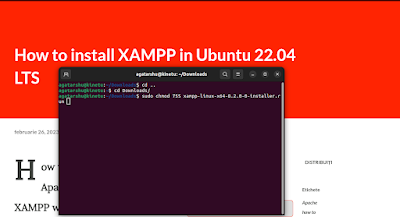How to install XAMPP in Ubuntu 22.04 LTS with [ Apache + MariaDB + PHP + Perl ] To install XAMPP with Apache, MariaDB, PHP, and Perl on Ubuntu 22.04 LTS, you can follow these steps:
 |
| How to install XAMPP in Ubuntu 22.04 LTS |
1. Download XAMPP:
2. Visit the official XAMPP website and download the Linux version of XAMPP that includes Apache, MariaDB, PHP, and Perl. Save the file to your Downloads folder.
Open the Terminal:
Open the Terminal by pressing Ctrl+Alt+T on your keyboard or searching for "Terminal" in the applications menu.
3. Navigate to the Downloads folder:
Type cd ~/Downloads in the terminal and press Enter to navigate to your Downloads folder.
4. Change the permissions of the downloaded file:
Type chmod +x xampp-linux-x64-8.2.0-0-installer.run and press Enter to make the downloaded file executable. Change the filename to match the version you downloaded.
5. Run the XAMPP installer:
Type sudo ./xampp-linux-x64-8.2.0-0-installer.run and press Enter to run the XAMPP installer. Enter your sudo password when prompted.
Follow the installation wizard:
The XAMPP installation wizard will guide you through the installation process.
6. Follow the instructions on the screen to install XAMPP with Apache, MariaDB, PHP, and Perl. You can choose to install any optional components you want as well.
7. Start XAMPP:
After the installation is complete, you can start XAMPP by typing sudo /opt/lampp/lampp start in the terminal and pressing Enter. This will start Apache, MariaDB, and other components of XAMPP.
8.Test XAMPP:
Open your web browser and go to http://localhost. You should see the XAMPP dashboard, which indicates that XAMPP has been successfully installed and is running on your Ubuntu 22.04 LTS system.
That's it! You have successfully installed XAMPP with Apache, MariaDB, PHP, and Perl on Ubuntu 22.04 LTS. You can now use XAMPP to develop and test web applications locally on your system.
Comentarii